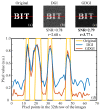Gradient-Descent-like Ghost Imaging
- PMID: 34833635
- PMCID: PMC8622126
- DOI: 10.3390/s21227559
Gradient-Descent-like Ghost Imaging
Abstract
Ghost imaging is an indirect optical imaging technique, which retrieves object information by calculating the intensity correlation between reference and bucket signals. However, in existing correlation functions, a high number of measurements is required to acquire a satisfied performance, and the increase in measurement number only leads to limited improvement in image quality. Here, inspired by the gradient descent idea that is widely used in artificial intelligence, we propose a gradient-descent-like ghost imaging method to recursively move towards the optimal solution of the preset objective function, which can efficiently reconstruct high-quality images. The feasibility of this technique has been demonstrated in both numerical simulation and optical experiments, where the image quality is greatly improved within finite steps. Since the correlation function in the iterative formula is replaceable, this technique offers more possibilities for image reconstruction of ghost imaging.
Keywords: denoising; ghost imaging; gradient-descent; image quality; image reconstruction; iteration.
Conflict of interest statement
The authors declare no conflict of interest.
Figures












References
-
- Shapiro J.H. Computational ghost imaging. Phys. Rev. A. 2008;78:061802. doi: 10.1103/PhysRevA.78.061802. - DOI
Grants and funding
LinkOut - more resources
Full Text Sources

